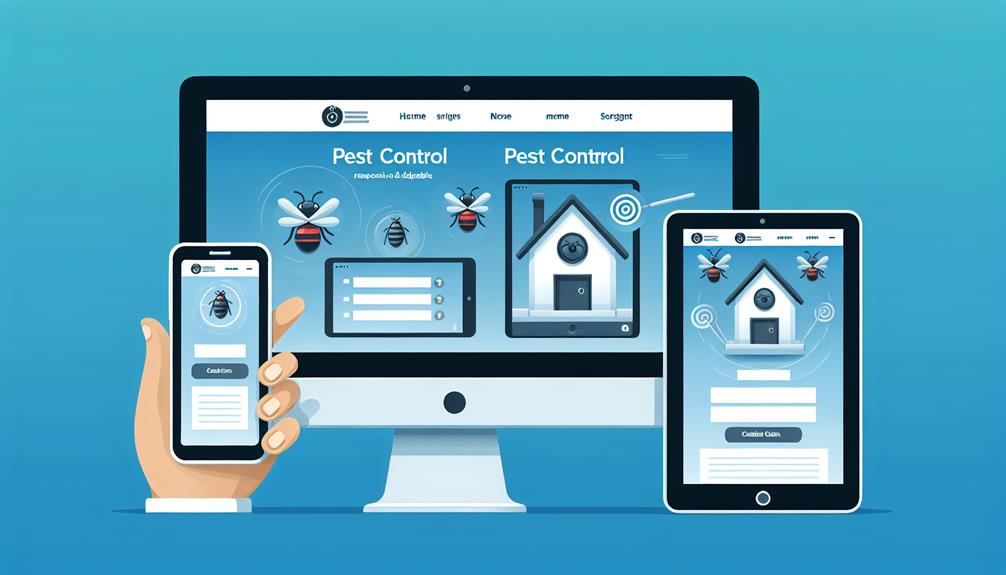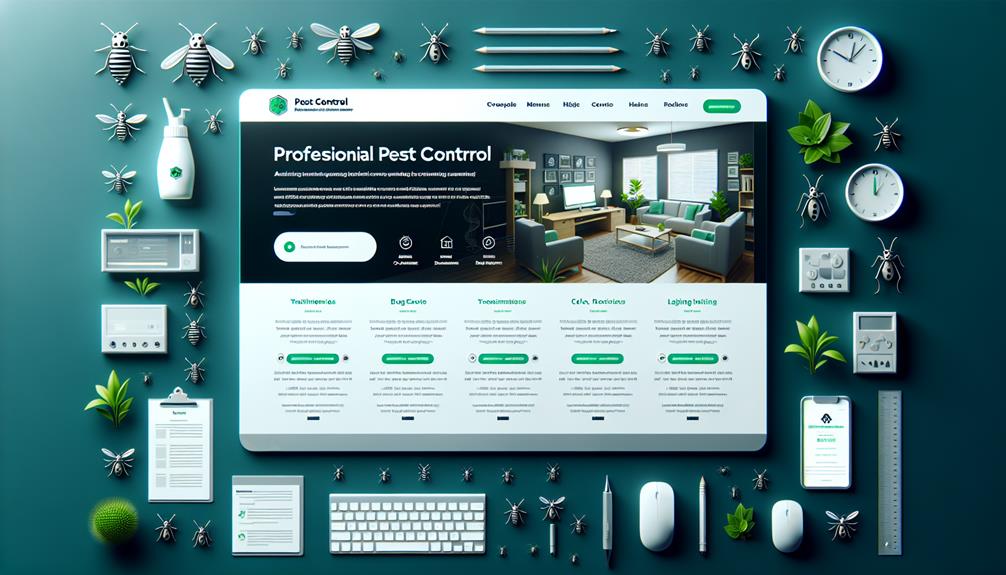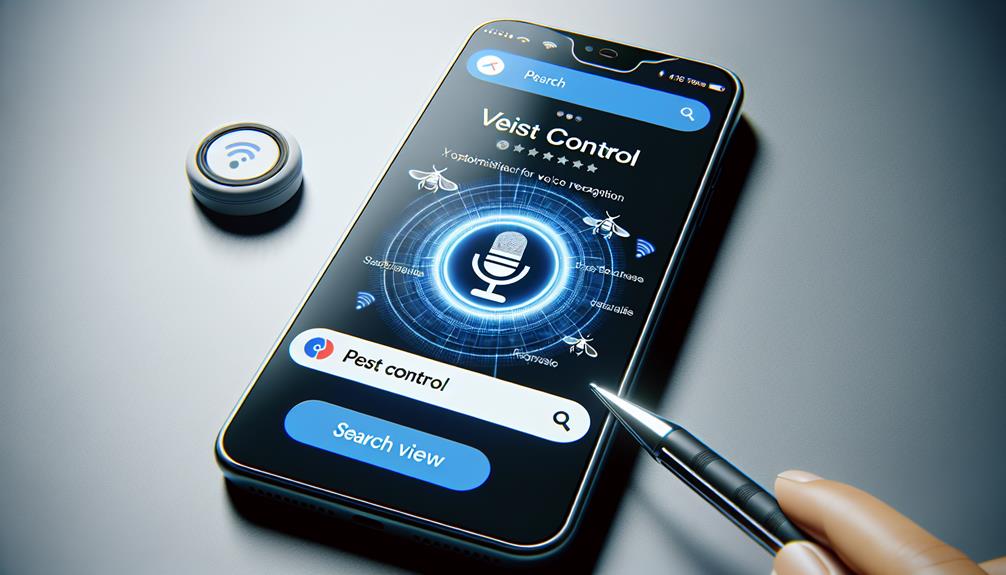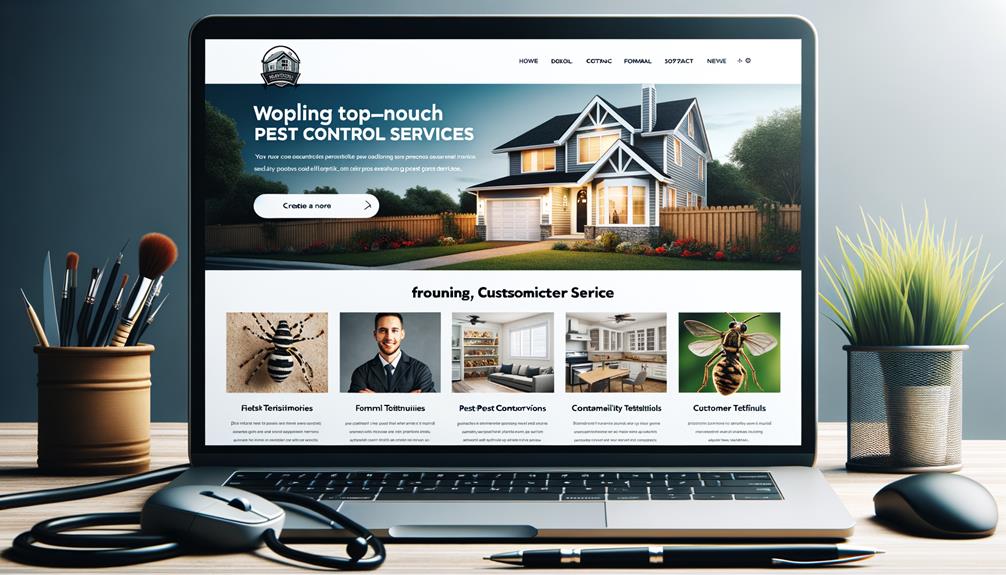Are pests invading your online presence? Don’t let them scurry away potential customers! With these 13 essential tips, you can exterminate any doubts about the effectiveness of your pest control website.
From responsive web design that adapts to any screen size, to clear and consistent navigation that guides users seamlessly through your site, these strategies will ensure that visitors don’t get caught in a web of confusion.
So, are you ready to take control of your online presence and watch your business soar?
Table of Contents
ToggleKey Takeaways
- Responsive web design is essential for creating a user-friendly and accessible pest control website that adapts seamlessly to different devices and screen sizes.
- Image optimization techniques, such as compression and appropriate file formats, are crucial for reducing loading times on both desktop and mobile devices, improving website performance.
- Clear and consistent navigation, user-friendly layout, and optimized page load speed contribute to enhanced user experience and engagement on pest control websites.
- Implementing features like click-to-call, contact forms, and social media buttons, as well as showcasing testimonials and reviews, can improve user interaction and conversion rates on pest control websites.
Responsive Web Design

Responsive web design is essential for creating a user-friendly and accessible website that adapts seamlessly to different devices and screen sizes. With the increasing use of smartphones and tablets, it’s crucial to ensure that your pest control website looks and functions well on all devices. Responsive web design allows your website to automatically adjust and optimize its layout and content for various screen sizes, providing a consistent and pleasant browsing experience for your visitors.
One aspect of responsive web design that you should pay attention to is image optimization techniques. Images are an essential part of any website, but they can significantly impact loading times, especially on mobile devices with limited bandwidth. By using image optimization techniques such as compressing, resizing, and using the appropriate file formats, you can reduce the file size of your images without compromising their quality. This not only improves the loading speed of your website but also enhances the user experience.
Implementing responsive web design and optimizing your images will ensure that your pest control website is accessible and user-friendly across all devices. It will help you reach a wider audience and improve your website’s performance and rankings on search engines. So, make sure to invest time and effort into these aspects to create a successful and effective website for your pest control business.
Clear and Consistent Navigation
Now let’s focus on the importance of clear and consistent navigation for your pest control website. When visitors land on your site, they want to find the information they need quickly and easily.
A responsive navigation system is crucial in achieving this goal. With responsive navigation, your website will adapt to different devices and screen sizes, ensuring that users can navigate seamlessly from desktop to mobile without any issues.
Additionally, an intuitive menu design is vital for providing a user-friendly experience. Your menu should be organized and easy to understand, allowing users to effortlessly locate the different sections of your website. By incorporating clear labels and logical categories, you can guide visitors to the relevant pages they’re looking for.
Remember, a cluttered or confusing navigation can quickly frustrate users and make them leave your site. Therefore, it’s essential to prioritize simplicity and clarity when designing your navigation.
User-Friendly Layout

When it comes to designing a user-friendly layout for your pest control website, there are a few key points to keep in mind.
First, focus on creating a clear and easy-to-use navigation menu design that allows visitors to quickly find the information they need.
Additionally, incorporate clear call-to-action buttons throughout your website to guide users towards taking the desired actions, such as scheduling an appointment or requesting a quote.
Navigation Menu Design
To create a user-friendly navigation menu design for your pest control website, focus on simplicity and ease of use. A responsive navigation is essential for a seamless user experience, allowing visitors to easily navigate through your website on any device.
Here are three key elements to consider when designing your menu layout:
- Clear and concise labels: Use descriptive and easily understandable labels for each menu item. Avoid using jargon or complicated terms that might confuse or frustrate users.
- Logical organization: Arrange your menu items in a logical order that makes sense to your visitors. Group related content together and consider using dropdown menus for subcategories to reduce clutter.
- Visual cues: Incorporate visual cues such as icons or indicators to help users quickly identify different sections or pages within your website.
Clear Call-To-Action Buttons
Creating clear call-to-action buttons is crucial for designing a user-friendly layout for your pest control website.
A responsive button design is essential to ensure that visitors can easily locate and interact with your call-to-action buttons, regardless of the device they’re using.
These buttons should be visually appealing, with clear and concise text that clearly communicates the desired action.
The placement of the buttons should also be strategic, ensuring they’re prominently displayed and easy to find.
By optimizing your call-to-action buttons for conversion, you can increase the likelihood of visitors taking the desired action, such as scheduling an appointment or requesting a quote.
Optimize Page Load Speed
Improve the speed of your pest control website by optimizing page load times. A slow-loading website can frustrate visitors and lead to higher bounce rates.
Here are three essential tips to optimize your page load speed:
- Improve server performance: A slow server can significantly affect your website’s load time. Consider upgrading your hosting plan to one that offers better performance and faster response times. Regularly monitor your server’s performance and make any necessary adjustments to ensure optimal speed.
- Minimize HTTP requests: Each element on your webpage, such as images, scripts, and stylesheets, requires an HTTP request to load. The more requests, the longer it takes for your page to load. Reduce the number of HTTP requests by combining and compressing files, using CSS sprites, and optimizing images. This will help streamline your website and improve its loading speed.
- Enable browser caching: When a visitor accesses your website, certain files are stored in their browser’s cache. Enabling browser caching allows returning visitors to load your website faster by retrieving files from their cache instead of making a new request to the server. This can significantly reduce load times and improve the overall user experience.
Mobile-Friendly Images

When it comes to mobile-friendly images for your pest control website, there are a few key points to consider.
First, you need to optimize your images to ensure they load quickly on mobile devices. This can be done through techniques such as compressing the file size and using the correct image format.
Additionally, it’s crucial to design your images to be responsive, meaning they adjust to different screen sizes and orientations.
Image Optimization Techniques
To optimize your website’s images for mobile devices, consider implementing mobile-friendly image techniques. This will ensure that your website loads quickly and looks great on any screen size. Here are three essential image optimization techniques to keep in mind:
- Image compression techniques:
Compressing your images reduces their file size without compromising on quality. Use tools like Adobe Photoshop or online image compressors to optimize your images for the web.
- Alt text optimization:
Alt text is essential for accessibility and SEO purposes. Be sure to include descriptive alt text for your images, using relevant keywords to improve your website’s visibility in search engine results.
- Responsive image design:
Use responsive image design to automatically adjust the size and resolution of your images based on the user’s device. This ensures that your images look sharp and load quickly on mobile devices.
Responsive Image Design
Implementing responsive image design is crucial for creating a mobile-friendly website that delivers an optimal user experience. With the increasing use of smartphones and tablets, it’s essential to ensure that your website is accessible and visually appealing on different screen sizes.
Responsive image optimization plays a key role in achieving this goal. By employing image compression techniques, you can reduce the file size of your images without sacrificing quality. This not only helps in improving the loading speed of your website but also saves bandwidth for mobile users.
Utilizing responsive image design ensures that your images automatically adjust and resize based on the device used, providing a seamless browsing experience for your visitors.
Importance of High-Quality Images
High-quality images are essential for creating a visually appealing and engaging mobile-friendly website. Here’s why:
- High resolution images: Using high resolution images ensures that your website looks professional and polished. These images are clear, sharp, and vibrant, capturing the attention of your audience.
- Visual storytelling: Images have the power to tell a story and evoke emotions. Incorporating compelling visuals on your website can help convey your brand message and create a connection with your visitors. Whether it’s showcasing before and after pictures of pest control services or displaying happy customers, high-quality images can make your website more persuasive and memorable.
- Mobile-friendly images: With the increasing use of mobile devices, it’s crucial to optimize your images for mobile viewing. This means choosing images that load quickly and are easy to view on smaller screens. By using mobile-friendly images, you ensure a seamless user experience and keep your audience engaged.
Incorporating high-quality, mobile-friendly images on your pest control website can make a significant impact on your overall user experience and conversion rates. So, invest in quality visuals to create a visually appealing and engaging website.
Use Legible Fonts

Choose a font that’s easy to read and enhances the overall user experience on your pest control website. Legible font choices are crucial in ensuring that your website is accessible and user-friendly.
When selecting a font, consider the typography trends that are currently popular in web design. Clean, sans-serif fonts like Arial, Helvetica, or Open Sans are often favored for their simplicity and readability. These fonts are widely used because they’re easy on the eyes and make it effortless for visitors to navigate your website.
Remember, the goal is to convey your message effectively, and using a legible font is essential in achieving that. Avoid using decorative or script fonts, as they can be difficult to read, especially on smaller screens.
Implement Click-to-Call Feature
To enhance user experience and streamline communication, adding a click-to-call feature is a valuable addition to your pest control website. With the rise of mobile marketing and the growing need for instant customer engagement, implementing this feature can greatly benefit your business.
Here are three reasons why you should consider adding a click-to-call feature to your website:
- Convenience: By allowing users to simply tap on a phone number to make a call, you eliminate the need for them to manually enter the number into their phone. This saves time and effort, making it more likely for potential customers to reach out to you.
- Increased conversions: A click-to-call feature makes it easier for users to contact your business, leading to higher conversion rates. When customers can easily connect with you, they’re more likely to inquire about your services or book an appointment.
- Instant communication: In the pest control industry, quick response is crucial. With a click-to-call feature, customers can reach you instantly, allowing for immediate assistance and resolving their pest problems efficiently.
Incorporate Contact Forms

Incorporate contact forms into your pest control website to streamline customer inquiries and improve communication efficiency. Contact forms provide a convenient way for potential customers to reach out to you with their pest control needs. By including a contact form on your website, you make it easy for visitors to ask questions, request quotes, or schedule services.
To make the most of contact forms, consider customizing them to collect specific information that will help you better understand your customers’ needs. For example, you can include fields for the type of pest problem, location, and any other relevant details. This customization allows you to gather valuable data that can inform your lead generation strategies and improve your overall customer service.
Furthermore, contact forms eliminate the need for customers to pick up the phone and make a call, which can be time-consuming and inconvenient. By offering a contact form option, you provide an alternative method of communication that caters to those who prefer written correspondence or may not be available to talk during business hours.
Integrate Social Media Buttons
Enhance the reach and engagement of your pest control website by seamlessly integrating social media buttons. Social media has become an essential tool for businesses to connect with their target audience and promote their services. By incorporating social media buttons on your website, you can tap into the power of social media marketing and expand your online presence.
Here are three reasons why integrating social media buttons is crucial for your pest control website:
- Increased visibility: When visitors come across an interesting article or service on your website, they can easily share it with their friends and followers on social media platforms like Facebook, Twitter, and Instagram. This not only boosts your visibility but also increases the chances of attracting new customers.
- Improved engagement: Social media buttons allow visitors to engage with your website content by liking, commenting, and sharing. This creates a sense of community and encourages interaction, helping you build a loyal customer base.
- Enhanced credibility: By integrating social media buttons, you showcase your active presence on social media platforms, which adds credibility to your business. Potential customers are more likely to trust a company that has a strong social media presence.
Include Testimonials and Reviews

By showcasing trustworthy client experiences, you can provide social proof of your expertise and credibility.
Positive word-of-mouth impact can also be generated by highlighting satisfied customers, encouraging others to choose your services.
Trustworthy Client Experiences
Clients’ trust is paramount when it comes to providing pest control services, and one effective way to showcase trustworthy client experiences is through testimonials and reviews. By including these on your pest control website, potential customers can gain insight into the quality of your services and the level of customer satisfaction you provide.
Here are three reasons why trustworthy testimonials and reviews are essential for your website:
- Authenticity: Genuine testimonials and reviews from satisfied clients create a sense of authenticity and credibility, reassuring potential customers that they can trust your services.
- Social proof: Positive reviews and testimonials act as social proof, demonstrating to potential customers that others have had a positive experience with your pest control services.
- Transparency: Testimonials and reviews provide transparency by giving potential customers a glimpse into the experiences of previous clients, allowing them to make informed decisions about your services.
Positive Word-Of-Mouth Impact
Testimonials and reviews on your pest control website have a powerful impact on spreading positive word-of-mouth about your services. Positive customer feedback plays a crucial role in building trust and credibility with potential clients.
When visitors see real people sharing their positive experiences with your pest control services, they’re more likely to choose your company over competitors. Testimonials and reviews act as social proof, reassuring potential customers that your services are reliable and effective.
By including these on your website, you can enhance your online reputation and increase the likelihood of attracting new clients. Encourage satisfied customers to leave reviews and testimonials, and make sure to showcase them prominently on your site.
Use Local SEO Strategies
To maximize your online visibility and attract local customers, implementing effective local SEO strategies is essential. Local SEO techniques focus on optimizing your website to rank higher in local search results, making it easier for potential customers in your area to find you.
Here are three key strategies to help you improve your local search optimization:
- Optimize your website for local keywords: Conduct keyword research to identify the search terms that people in your area are using to find pest control services. Incorporate these keywords naturally into your website’s content, including your page titles, headings, and meta descriptions.
- Claim and optimize your Google My Business listing: Creating a Google My Business profile allows you to appear in local search results and on Google Maps. Make sure your listing is complete and accurate, including your business name, address, phone number, and website. Encourage customers to leave reviews, as positive reviews can improve your rankings.
- Build citations and get listed in local directories: Citations are mentions of your business’s name, address, and phone number on other websites. Getting listed in local directories and online review sites can improve your local search visibility. Ensure that your business information is consistent across all platforms.
Optimize for Voice Search

To further enhance your pest control website’s visibility and reach, it’s important to optimize for voice search. With the rise of smart speakers and virtual assistants like Siri and Alexa, more and more people are using voice commands to search for information online. By optimizing your website for voice search, you can ensure that your business is easily found by potential customers.
One key aspect of voice search optimization is keyword research. When people use voice commands to search for pest control services, they often use longer and more conversational phrases compared to traditional text-based searches. Therefore, it’s essential to identify and incorporate these long-tail keywords into your website’s content. This will help your website rank higher in voice search results.
In addition to keyword research, it’s crucial to provide concise and direct answers to common questions that users may ask. Voice search queries often seek immediate answers or solutions. By addressing these queries on your website, you can increase your chances of appearing in voice search results and attract potential customers.
Regularly Update and Maintain Website
Regularly updating and maintaining your pest control website is essential for ensuring its functionality, relevance, and user experience. By following these two key practices, you can keep your website up-to-date and in optimal condition:
- Regular content updates: Keeping your website content fresh and relevant is crucial for engaging your audience and improving search engine rankings. Regularly update your blog with informative articles, tips, and industry news. This not only provides valuable information to your visitors but also signals to search engines that your website is active and authoritative.
- Website maintenance: Regularly maintaining your website ensures that it remains secure, fast, and user-friendly. Perform regular backups to protect your data in case of any unforeseen issues. Check for broken links, update plugins and themes, and optimize images for faster loading times. Regularly monitoring your website for any technical issues or errors will help provide a seamless browsing experience for your visitors.
- Optimize for mobile: With the increasing use of mobile devices, it’s crucial to optimize your website for mobile users. Ensure that your website is responsive and mobile-friendly, allowing users to navigate easily and access information on any device.





